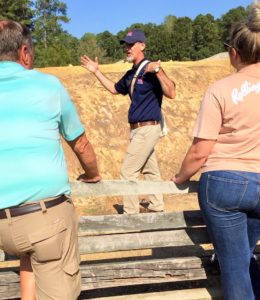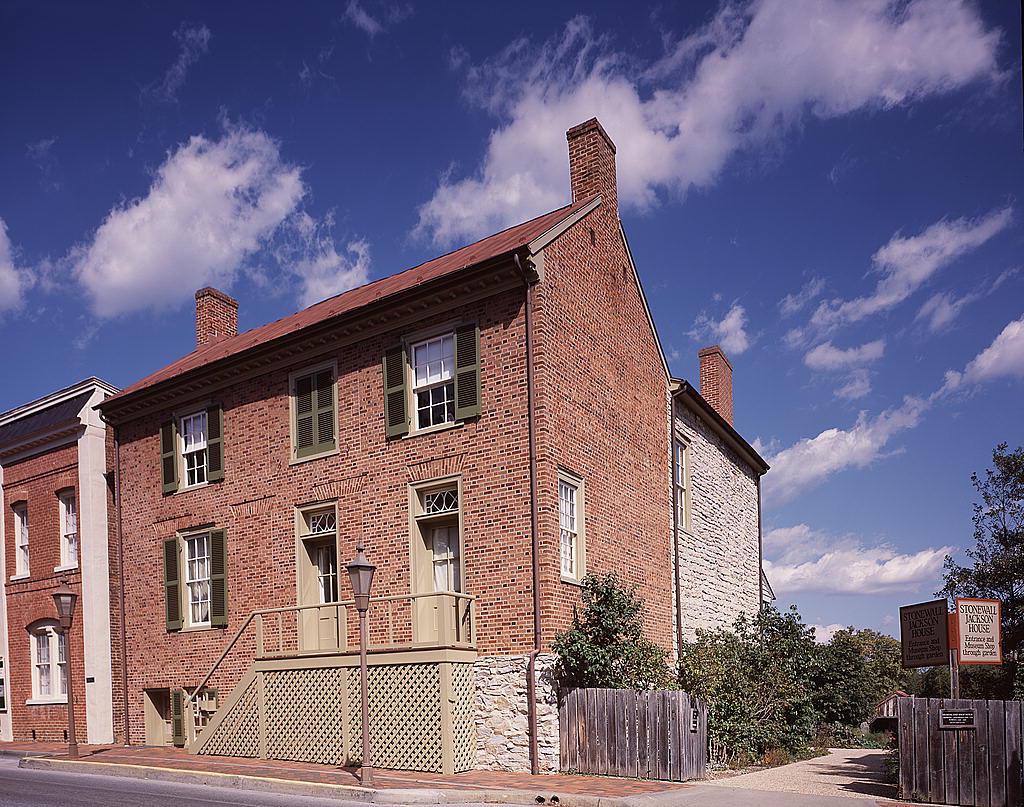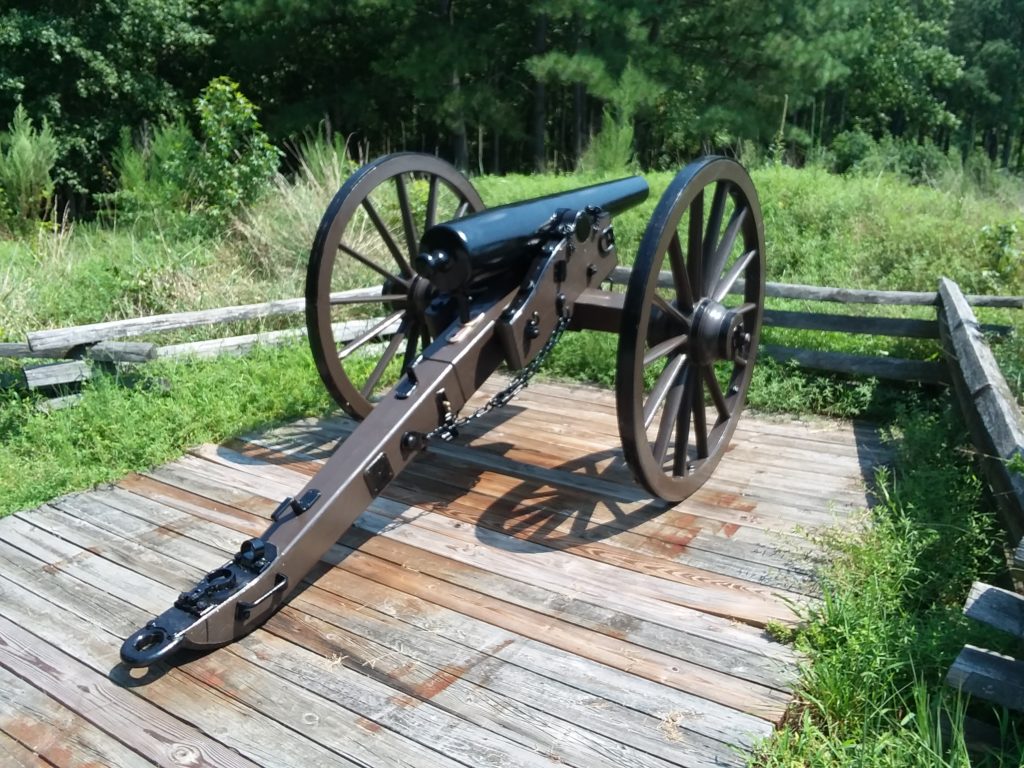
Like many Civil War enthusiasts, BGES member Tim Talbott’s interest in America’s most transformative event is a family affair. Indeed, his love of history was driven by his parents and grandparents. Today, it plays out in his role as Director of Education, Interpretation, Visitor Services & Collections at Pamplin Historical Park and the National Museum of the Civil War Soldier. He took time out of his busy schedule to talk about keeping Civil War history alive in these challenging times.
BGES Blog: Let’s start with some personal background. Where were you born? Where did you grow up? What was life like as a kid?
TT: I was born in Harriman, Tennessee, which is just west of Knoxville. When I was 9, my family moved to historic Madison, Indiana (on the Ohio River), and I spent my third grade through twelfth grade years there. My childhood years were great. I spent a lot of time with my father and brother hunting and fishing in southern Indiana’s area’s fields, forests, and streams, learning about having a healthy respect for nature. After finishing high school I returned to East Tennessee to attend Milligan College and graduated with a degree in Communications. After about 10 years working in the business world, I burned out and went back and earned my bachelor’s degree in History from East Tennessee State University.
BGES Blog: When did your interest in American history and Civil War begin? How did you feed it?
TT: My parents are both from Kentucky and my grandparents lived there when I was growing up. My brother and I were fortunate that we got to spend a significant amount of time each summer visiting with our grandparents. They would tell us interesting family stories and share family history. My dad was a minister, but for a few years before I was born he also did some substitute teaching for American history classes at a local high school. He was a history enthusiast anyway and had acquired a lot of books about different periods of U.S. history, so those were always at hand while I was growing up and developing my interests. My fourth grade (Indiana History) and fifth grade (U.S. History) teachers emphasized the importance of learning history by doing local projects, so that helped get me hooked, too.
As far a Civil War history, my dad took me to the Perryville battlefield one year on the way back from visiting my grandparents. This was about 1981 or so, and there was not much there at that time. But the little museum and the artillery really spoke to me and my budding interest in the Civil War. The next year, Dad took me to the annual reenactment at Perryville. Seeing the uniforms, the guns, the flags and hearing the cannons and smelling the smoke from the camps and cannons made a distinct impression on me.
Both of my parents encouraged me to learn more about what was now my primary area of interest. My mother drove me to our local reenactments to participate, before I was able to drive. She also made countless trips to take me to our local library, which helped fuel my interest. Through my high school years and first three years at Milligan, my Civil War obsession receded, but it never went away. When I watched Ken Burns’ documentary while in college, I became hooked again, and have been ever since.
BGES Blog: One specific area of interest for you is the U.S. Colored Troops. What made you gravitate to USCT? How has your study of them enhanced your understanding of American history?
TT: As a youngster I remember seeing pictures of USCTs in many books. I read about the 54th Massachusetts at Battery Wagner and the soldiers at Milliken’s Bend, but it wasn’t until I was working on completing my undergraduate history degree that I began to fully understand and appreciate how much the USCTs contributed toward the Union war effort. I had the opportunity to research and learn about their service even more when I started into my public history career, and even more so when I worked for the Kentucky Historical Society.
Many Civil War enthusiasts do not know that Kentucky was second only to Louisiana in sending soldiers to USCT regiments. However, it was the act of diving deeper into USCT primary sources that really made a distinct impression on me and made me want to bring greater awareness to their story. Here were men who came from diverse geographical locations, both free and formerly enslaved, putting their lives on the line for a government that did not view them yet as citizens. They also often received difficult fatigue duties, served in unfavorable locations, initially experienced unequal pay, and many times endured the disdain of their white Union comrades. Yet they did their duty, and did it well. Even with movies like Glory, and with more scholarship coming out all the time, the USCT soldier story is still quite foreign to your average Civil War buff, and practically unknown to the average U.S. citizen. I helped form the Battle of New Market Heights Memorial and Education Association to try to help correct that. It is my hope that by giving USCT soldiers’ stories more exposure we can is some way heal some of the racial divisiveness that his plaguing our society.

BGES Blog: While getting your MA in Public History at Appalachian State, you served as a Graduate Fellow at the Stonewall Jackson House. What was that experience like?
TT: The three summer months that I spent at the Stonewall Jackson House were a dream come true. Not only did I receive a stipend, I also got to immerse myself in researching one of the Civil War’s most recognizable personalities. The project I chose to complete was to research the material culture items listed on Jackson’s estate inventory and develop a “collections needs booklet” for the Jackson House to use as they attempted to acquire those items for interpreting the house and grounds. I learned so much—about mid-19th-century material culture, about the research process, about synthesizing my findings, and about presenting my work to others. I often think fondly of the friends that I made and the wonderful experience I had there.
BGES Blog: What’s your favorite part of your job at Pamplin Historical Park and the National Museum of the Civil War Soldier? What kind of impact has the Covid pandemic had?
TT: From my formal job title it’s quite easy to see that I wear a lot of different hats. That is one aspect of my job that I especially enjoy. I get to do different things almost every day. One day I may be hilling and planting tobacco in our crop demonstration field; the next day I may be leading a custom tour of the Petersburg Campaign. One day I may be researching an artifact or document in our collections for a story in our local newspaper; the next day I may be leading a group of fourth graders through our education programs.
I am fortunate that I get to lead the Petersburg Civil War Roundtable as part of my job. That opportunity has allowed me to learn so much and to network with some of the field’s top scholars. I am a voracious reader, so getting to meet and chat with some of my favorite historians is a definite perk. If I had to narrow it down to just one thing, the favorite part of my job would be those many experiences of sharing the value of learning about the Civil War era. That period had such a profound impact on the United States, and of course, many of the changes of that time are still relevant in 2020.
The pandemic has had a tremendous impact on Pamplin Historical Park. It arrived just as we were getting ready to start our big spring school season. The revenue that the park earns during the months of March through May by serving the little visitors who arrive on school busses simply vanished when schools closed. That group revenue helps us throughout the year, and it just wasn’t there this year. The loss of those funds in turn resulted in the loss of five fulltime staff members. The pandemic also meant that we had to cancel a number of revenue generating special events including our anniversary Breakthrough Weekend.
With a reduced staff we are now only able to be open six days of the week instead of seven, and we’ve had to cut daily programming down somewhat in order to handle make sure other necessary tasks get accomplished. We opened back up on May 15, but visitation has been down due to a reduction in folks traveling and getting out. Understandably, some of our volunteers—many of whom are retirees—are still hesitant to return due to concerns for their personal health. So, yes, the pandemic has provided us with a huge challenge. However, it has also revealed the strength and resiliency of our staff and volunteer team and our commitment to history education and preservation. Any help that folks reading this might be able to give in financial contributions or in-kind volunteer assistance is certainly appreciated.

BGES Blog: Pamplin Park is replacing a cannon carriage. Talk about the project and what the refurbished cannon will be used for.
TT: The reproduction 12-pound Napoleon’s wooden carriage that BGES helped fund about 12 years ago fell victim to Virginia’s diverse weather over that period. Unfortunately, we do not have a covered space large enough to move the artillery piece to protect it. Additionally, it serves as a static interpretive tool along the earthwork line when not being used. Changes in temperature and exposure to the elements naturally deteriorated some of its wood and required a method for replacement due to safety concerns.
We decided that an all-weather aluminum carriage would be the best long-term option, so I contacted BGES to see if they would again help fund the project. I am happy to say that they stepped up big time and funded almost 40% of the new carriage cost. As an attempt to partially return the favor, the park is donating the old wooden carriage to BGES to refurbish and repurpose at another location. The new artillery carriage and its reproduction tube will be placed back along the earthwork line where the Norfolk Light Artillery Blues defended on April 2, 1865. The piece will also continue to be used as a demonstration tool for the Civil War Adventure Camps, which we host adjacent to that part of the Park grounds, as well as for special event firings. We sincerely appreciate the BGES and its members’ assistance with this project.
BGES Blog: What was your introduction to BGES? What do you enjoy about the group?
TT: I became familiar with the BGES during my first tour of duty at Pamplin Historical Park, which was 2006 to 2009. I’ve always been impressed with the projects that BGES takes on and the diversity and quality of the tours they offer. Their mission of history education and preservation is one that is in accord with Pamplin Historical Park’s, as well as my own. I think that in the current climate of our society, where history education is not getting the emphasis it so justly deserves, it is incumbent upon all Civil War organizations to work together as much as possible.
BGES Blog: You recently did a birthday fundraiser for BGES on Facebook. Why? What kind of response did you get?
TT: Yes I did. I partly did it because I want my friends and acquaintances on Facebook to know how much I care about history. Most probably already do know, but I also wanted to draw some awareness to BGES as well. It is my hope that perhaps one of my Facebook friends saw my birthday fundraiser, and even if they didn’t give any funds, hopefully they investigated what BGES does and offers, and at minimum became more aware of this great organization. I believe that I set a goal to raise $250, and my friends helped achieve the goal. Anyone in the public history field knows that every little bit matters.
BGES Blog: Thanks for all the great work you’re doing, Tim!
